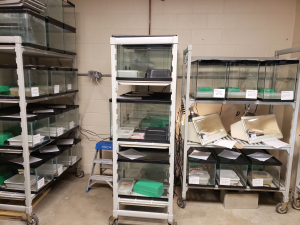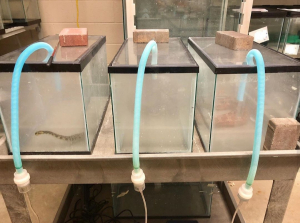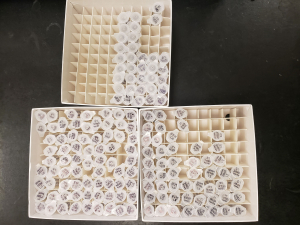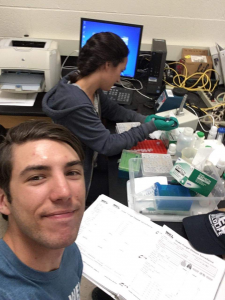Back at the lab, after getting all of the LEWS in their tanks after the long drive, we maintained a quiet week to give the snakes a chance to settle in and get used to their new surroundings. They joined our other clinical case snakes at WEL, some of whom have SFD and are currently undergoing treatment, and others who have successfully been treated and now serve an important role as educational animals!

Our SFD room… filled with LEWS!
Before starting treatment for the LEWS, we need to analyze the swabs we took to determine their SFD status. This means sorting the hundreds of swabs we brought back for various projects within WEL. Each of these samples needs to be extracted for fungal DNA, and then analyzed with qPCR to determine fungal copy number of Ophidiomyces on each swab. This process tells us if the snakes have SFD present on their skin.
Currently, we treat snakes within WEL with terbinafine, an antifungal, via nebulization for 30 minutes a day for 30 days. Nebulization works to fight Ophidiomyces in two ways: the snake breathes in the anti-

Our nebulization setup with some of our clinical case snakes undergoing treatment
fungal drug and the drug coats the snake’s skin. This gives us the ability to fight Ophidiomyces systemically within the snake and topically on the skin’s skin. We then re-swab the snakes after the thirty days and determine if they are still positive. Some snakes will test negative after one round of treatment, but many others require repeat rounds to fully fight off the disease.
Working with the Stone Lab and participating in Nerodio offer us the chance to learn so much about SFD epidemiology, pathogenesis, treatment and prevention. We are always grateful for the opportunity to work with LEWS and have access to the abundance of data we collect, even during these weeks filled with lab time!

Boxes and boxes of swab samples

Fun with data entry and DNA extractions!
